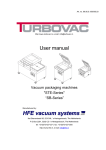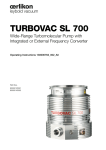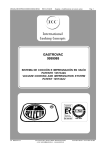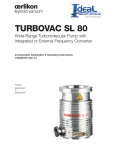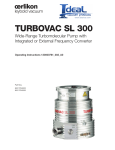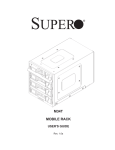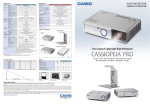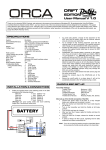Download Turbovac User manual
Transcript
Manufactured by: Het Sterrenbeeld 36, 5215 ML ‘s-Hertogenbosch The Netherlands P.O.Box 2261, 5202 CG ’s-Hertogenbosch The Netherlands tel: +31(0)73-6271271, fax: +31(0)73-6271200 http://www.hfe.nl, e-mail: [email protected] Englisch 2004 HFE Vacuum Systems BV All rights reserved. No part of this document may be reproduced and/or published by means of printing, photocopy, microfilm or any other method, without the prior written permission of the manufacturer. This also applies for the accompanying illustrations and/or diagrams and schematics. The information in this document is based on the general data associated with the construction, material qualities and working methods, known at the moment of publication, so that we reserve the right to make changes without giving prior notice. This document is applicable to the indicated models of the Turbovac packing machine in the version supplied. The manufacturer therefore does accept any liability for any form of damage or injury resulting from deviating from the specifications of these machines as supplied to you. All possible care was taken when creating this document, but the manufacturer accepts no liability for mistakes or any consequences thereof. TAKE THE TIME TO READ THIS DOCUMENT THOROUGHLY TO ACQUAINT YOURSELF WITH THE CORRECT AND APPROPRIATE USE OF THE VACUUM PACKING MACHINES. 2004-01 II User manual ECONOMY-range Contents CONTENTS SAFETY AND WARNING NOTICES................................................................................................ 4 1 INSTALLATION ........................................................................................................................... 5 2 OPERATION ................................................................................................................................ 6 2.1 2.2 2.3 2.4 Warm up position ................................................................................................................................. 6 Vacuuming and Sealing ....................................................................................................................... 6 Vacuuming ........................................................................................................................................... 6 Sealing ................................................................................................................................................. 6 3 LOOKING AFTER YOUR MACHINE........................................................................................... 8 3.1 3.2 3.3 3.4 3.5 3.6 Warnings.............................................................................................................................................. 8 Clean Daily........................................................................................................................................... 8 Weekly maintenance (See Section below “Seal bar Check list”) ......................................................... 8 Monthly maintenance........................................................................................................................... 8 Annual maintenance ............................................................................................................................ 8 Oil ........................................................................................................................................................ 8 4 SEAL BAR CHECK LIST............................................................................................................. 9 4.1 4.2 4.3 4.4 4.5 4.6 4.7 Replacing the sealing wire and Teflon tape ....................................................................................... 10 Replacing the sealing wires ............................................................................................................... 10 Replacing the Teflon tape .................................................................................................................. 10 Reinstalling a new sealing bar ........................................................................................................... 10 Replacing the silicone in the counter bar ........................................................................................... 10 Maintenance of the silicone gasket in the lid .................................................................................... 10 Replacing silicone gasket in the lid ................................................................................................... 10 5 TECHNICAL DATA .................................................................................................................... 11 6 PROBLEMS AND SOLUTIONS................................................................................................. 13 User manual ECONOMY-range III Safety and warning notices SAFETY AND WARNING NOTICES Warning Read the User Instructions thoroughly before starting to install and operate this machine. To avoid risk of electric shock or damage to the machine, always switch off the machines and isolate from the power supply before carrying out any maintenance or cleaning. Make sure at all times that this manual is within easy reach to refer to. CAUTION: Never use the machine without the seal bar installed. Before vacuum packing any sauces, soups or other liquids refer to the relevant section in the Operating chapter for correct and safe setting up of the machine. 4 User manual ECONOMY-range Installation 1 INSTALLATION • • • • • • • • • Make sure the machine is level and has been placed on a solid level .surface. To ensure easy access for maintenance and sufficient ventilation, the machine must not be closed in and is easily accessed from all sides. The main cable must be routed in such a manner to minimize any tripping hazard or that will cause damage to it. Before connecting the machine to the mains make sure that the voltage stated on the specifications plate is the same as that of the mains supply and that the connection is properly earthen. The standard machine must be connected to 230 Volt - 1 phase - 50 Hertz (depending on the country). Check the oil level. It is crucial that there is enough oil in the machine. If the machine has been supplied without oil, (see chapter “Looking After Your Machine” section entitled “Oil”). The temperature in the workspace should not be lower than 10°C, as the oil in the vacuum pump will thicken and prevent the smooth operation of the pump. Before you start with the vacuum process, familiarize yourself with the procedure. Don’t just start vacuuming sauces or other liquid products. When vacuuming sauces or soups, the pressure in the vacuum chamber must be carefully monitored, because the boiling point of liquids is lower as the vacuum percentage goes up. As soon as the boiling point has been reached, you can see the gas bubbles in the product. User manual ECONOMY-range 5 Operation 2 OPERATION The models Economy MINI, MAXI, Gastrovac, Gastrovac PRO and SUPER are machines that functions automatically, When the filled vacuum pouch has been put in the vacuum chamber and the lid is closed the operation will start automatically. The machine will automatically follow the entered program from vacuuming to sealing. After the sealing has been completed the vacuum pump will turn off and the lid will automatically open. 2.1 Warm up position After the machine has been switched off for a period of time we recommend that the machine is “warmed up”. Set the On/Off switch in the position WARM UP (B). Allow the pump to run (10 minutes max.). the main switch can then be reset to ON. The machine is ready to be used. 2.2 Vacuuming and Sealing Set the On/Off Switch (B) to position ON. The red light will light up, (adjacent to the switch) to indicate that the machine is ready to be used. The vacuum chamber contains filler plates. When the vacuum pouches are filled, a number of the filler plates must be removed (or not for smaller packs) so that the vacuum pouch lies directly on the sealing bar, ensure that the pouch lies half above the bar and half below it. The vacuum pouches should never stick out of the machine to stop the lid closing, NEVER TRY TO FORCE THE LID CLOSED. 2.3 Vacuuming Depending on the desired vacuum, the vacuum dial (C) on the control panel can be set. A red light (D) serves as a control indicator of the vacuum time. Start with position 3. If there is insufficient vacuum, set the dial to a higher value. The attained vacuum can be seen on the vacuum gauge (G) on the right side of the control panel. It is important that the vacuum time for products with enclosed air is extended. 2.4 Sealing The seal time is set by the seal dial (E), The red light (F) serves as a control indicator of the sealing time. Starting with position 3, if the sealing time is too long (scorching the bag), set the dial to a lower value; if the sealing time is too short (the sealed product easily opens), set the dial to a higher value. 6 User manual ECONOMY-range Operation A B C D E F G -0.6 -0.4 -0.2 -0.8 -1 bar -0 acc.1.6 Fig. 2-1 A. B. C. D. E. F. G. On/Off indicator On/Off Switch Vacuum dial Vacuum indicator Seal dial Seal indicator Vacuum gauge User manual ECONOMY-range 7 Looking after your machine 3 LOOKING AFTER YOUR MACHINE Regular and thorough maintenance prevents breakdowns, prolongs the machine’s operational life and guarantees optimum hygiene. 3.1 Warnings • • • • 3.2 Clean Daily • • • • • 3.3 • Check the condition of the oil. (See “Oil” section below for correct specification) Note: Replace the oil after 160 hours of operation. If the machine is not used frequently, change the oil every 6 months. Annual maintenance • • • 3.6 Check the oil, add oil if necessary. (Section below correct oil specifications) Check the condition. Check the silicone gasket in the lid; replace if damaged. Check the silicone strip in the counter bar; replace if damaged. Monthly maintenance • 3.5 Clean the lid, insert plates, bottom and walls of the vacuum chamber with a damp clothe. Pay particular attention to the silicon strip in the lid. Do not clean the transparent lid with synthetic cleaning agent as this weakens the acrylic material. Clean the control panel with a dry cloth. In order to prevent oxidation in the pump, the vacuum pump must run for about 5 minutes after cleaning, (see “Warm up” procedure) to allow the condensed water in the oil can evaporate. Weekly maintenance (See Section below “Seal bar Check list”) • • • • 3.4 Always unplug the machine when carrying out maintenance or repairs. To prevent accidents always replace damaged or oxidized gas or torsion springs in the lid. Never use high-pressure water to clean the machine as this can cause irreparable damage to the machine and to the electronics. An authorized service representative must carry out repairs. Check the condition of the vacuum hoses and pipes and replace them if necessary. Check the condition of the silicone strip of the counter bar and replace if necessary. Check the condition of the gas springs in the lid and replace them if necessary. Oil The oil in the vacuum pump must be checked and replaced on a regular basis. 8 User manual ECONOMY-range Seal bar check list 4 SEAL BAR CHECK LIST • • • • • Clean the sealing and counter bars daily to ensure optimum sealing of the packaging material. Use a dry cloth for this purpose. Check the condition of the sealing wires regularly. They should be free of kinks and should be tightly strung on the sealing bar. For flawless operation the Teflon tape must be free of damage. If the sealing wires or the Teflon tape are damaged, replace them immediately. Check the counter bar. This is made of silicone, which generally has a long operational life and therefore does not need replacing often. However, if parts of the beam are scorched, replace the silicone strip immediately. Ensure that spare sealing wires and Teflon tape are always kept in stock. (1) 12.15.0.0030 120-ST: 140-ST: 160-ST: 180-ST: 220-ST: (6) 12.03.0.0140 (6) 12.03.0.0140 (6) 12.03.0.0110 (6) 12.03.0.0120 (6) 12.03.0.0120 (2) 11.09.0.0020 (3) 06.03.1.0020 120-ST: 140-ST: 160-ST: 180-ST: 220-ST: 94.01.0.0355 94.01.0.0355 94.01.0.0375 94.01.0.0385 94.01.0.0385 (4) 01.09.1.0100 (5) 01.05.2.5016 Fig. 4-1 1. 2. 3. 4. 5. 6. Teflon tape Sealwire Spring Screw Hexagon nut Beam User manual ECONOMY-range 9 Looking after your machine 4.1 Replacing the sealing wire and Teflon tape Remove the sealing bar from the chamber. Remove the damaged Teflon tape from the seal bar. Unlock and remove the two (M6) grub screws (that retain the seal wire) from the underside of the seal bar using a 4mm-hexagon key. Remove the damaged seal wire. Carefully clean the sealing bar. 4.2 Replacing the sealing wires 1. Ensure that the two tension spring and screw assembly are in place in either end of the seal bar. 2. Fold over 50mm of the end of the new seal wire, push this end into the slot (underneath the seal bar) so that it extends beyond the (hole) position where the electrical pin contacts in the chamber fit. Clamp this end of the wire into place with the (M6) grub screw. 3. Run the remaining length of the wire along the top of the bar, fold over the end and fit similarly at this opposite end as the first, ensure that both (M6) grub screws are tightly secured. 4.3 Replacing the Teflon tape Remove the protective paper backing strip (from the new Teflon tape strip) and stick the tape onto the bar. Ensure that the tape overlaps the ends of the seal bar. 4.4 Reinstalling a new sealing bar Put the repaired sealing bar back into the chamber over the plug pins. On machines with the sealing bar in the lid the contact points must be reconnected. 4.5 Replacing the silicone in the counter bar Pull the silicone strip out of the groove, clean the groove and fit the new strip. 4.6 Maintenance of the silicone gasket in the lid Clean the silicone gasket with a damp cloth. Never use synthetic cleaning agents. If the gasket is damaged replace immediately as this will reduce the efficiency of the machine. 4.7 Replacing silicone gasket in the lid Remove the damaged gasket. Cut a length of new silicone gasket to match the old strip clean the groove and press the new gasket into place. Make sure the ends of the strip are pressed evenly together. No leakage should occur! 10 User manual ECONOMY-range Technical data 5 TECHNICAL DATA Data per machine Type 120-ST Height Width Depth Weight Length Width Depth Weight Length Width Depth Sealing configuration 1 x sealing beam Capacity 50 Hz 60 Hz 140-ST ECONOMY 160-ST Size and weight of the machine mm 380 380 415 mm 330 330 415 mm 460 460 520 Kg 31 41 55 Size and weight of the packed machine mm 500 580 700 mm 540 540 540 mm 630 630 630 Kg 36 46 65 Size of the vacuum chamber mm 365 365 340 mm 280 280 320 mm 130 130 135 Net sealing length mm 270 270 320 Final pressure Oil quantity Weight vacuum pump Noise 50 Hz 60 Hz m³/h m³/h mBar Ltr Kg Db(A) Db(A) Maximum leakage 0.1 mbar/s Vacuum pump 3 8 3.6 9.6 15 2 0,06 0,25 5.1 10.3 59 59 59 59 16 19 2 0,3 18 60 64 180-ST 220-ST 470 550 580 68 990 535 655 700 650 630 83 370 420 170 530 455 110 420 420 16 19 2 0,3 18 60 64 21 24 2 0,5 19 62 62 General data Recommend kinds of oil VM 068 VM 100 VS 100 or VC 101 Tension, power, frequency Maximum permissible voltage variance Ambient temperature Transportation temperature Humidity Positioning With a surrounding temperature of 5 - 12º C 12 - 30º C 30 - 40º C Electrical connections See the identification - 10% to + 10% Ambient conditions + 5 to + 30º C - 25 to + 55º C 30 % to 95 % (without condensation) Inside, level, free of walls, ect, • Voltage data was not included in this summary because these are dependent on the electricity supply of the country that the machine is intended for. The voltage data are given on the machine indentification plate. • The useful space in the vacuum chamber depends on the number of sealing trays ant their positioning. Each tray lessnes the useful space by about 50 mm. • Sizes and weights are for the standard (simples) model machines. User manual ECONOMY-range 11 Problems and solutions 6 PROBLEMS AND SOLUTIONS Problem Cause Solution Machine does not work. • The plug is not inserted in the socket correctly • Push the plug into the socket correctly • The On/Off switch is in the ‘OFF’ position. • Put the switch in the ‘ON’ position. • A fuse in the machine is ruptured. • Contact your authorized service representative The machine does not • The lid micro switch is work, but the lights are on. damaged • Contact your authorized service represetatived • The thermal safeguard has • Check if the ventilation openings are switched the machine off due to free from obstructions. overheating. -Let the machine cool down and switch. on again Contact your authorised service representative if the fault persists • A fuse could have.ruptured • Contact your authorized service representative • There is an internal malfunction. • Contact your authorized service representative The vacuum pump is not functioning correctly • The oil is too thick, the temperature is too low. • Let the pump warm up. (see “Warm up” procedure) There is insufficient vacuum. • The value entered for the vacuum function is too low. • Increase the value of the vacuum function • There is not enough oil in the pump. 12 Replenish the oil. • The oil is dirty. • Change the oil. • The suction filter is blocked • Contact your authorized service representative • The pump’s spray filter is blocked • Contact your authorized service representative • The lid’s silicone gasket is damaged. • Replace the silicone gasket User manual ECONOMY-range Problems and solutions Problems Cause Solution Insufficient vacuum in the bag • The vacuum pouch is of inferior quality. • Select vacuum pouches of a better quality. • The product has damaged the pouch. • Use a new pouch. • There is insufficient room between the sealing bar and the counter bar • Check the position of the sealing bar • The vacuum pouch is incorrectly placed on the sealing bar. • Place the opening of the vacuum pouch over the sealing bar correctly. • The sealing time is not set correctly. • Adjust the sealing time value. • There is a break in the sealing wire. • Replace the sealing wire. • The sealing bars are dirty. • Clean the sealing bars. • The Teflon tape is worn. • Replace the Teflon strip • The counter bar is damaged. • Replace the silicon strip. • The vacuum pouches are of inferior quality. • Select better quality vacuum pouches. • The opening of the vacuum pouch is contaminated. • Remove any obstructions from the opening of the pouch. Make sure the opening of the package remains clean while filling. or replace the bag The vacuum pouch is incorrectly sealed. User manual ECONOMY-range 13 14 User manual ECONOMY-range















